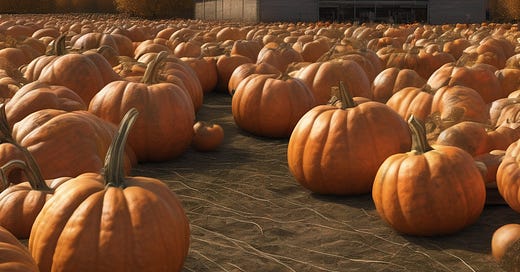"The Black Pumpkin" (1986) by Dean R. Koontz
Rod Serling's Twilight Zone Magazine v06n05 (1986 12)
Readers unfamiliar with "The Black Pumpkin" may prefer to read these notes only after reading the story.
Rod Serling's The Twilight Zone Magazine and The Magazine of Fantasy and Science Fiction were the only nationally distributed professional magazines oriented toward horror in my teen years. Going back through those issues of TZ on archive.org today, I am stunned: I read all the nonfiction matter, but let most of the fiction slip through my fingers.
"The Black Pumpkin" by Dean R. Koontz was one of the short stories I missed in a bumper issue of Halloween stories, which kicked off with a book review by E. F. Bleiler and a Koontz interview conducted by Joe. R. Lansdale.
"The Black Pumpkin" offers petty bourgeois moralizing along E. C. Comics lines. Young Tommy Sutzmann fills the thankless role of punching bag for his family. Older brother Frank is a jock and a bully; we know he's a no-goodnick because he has posters of slasher films and Michael Berryman on his walls. Plus, he enjoys pushing Tommy around. Mom and Dad Sutzmann are no prizes either.
Some families taught their twelve-year-old boys honesty, integrity, decency, and faith in God. But by their actions, Tommy’s parents and his brother Frank had taught him caution and paranoia. In the best of times his mother and father treated him as an outsider; in the worst of times, they enjoyed punishing him as a means of releasing their anger and frustration at the rest of the world. To Frank, Tommy was simply—and always—a target. Consequently, uneasiness was Tommy Sutzmann’s natural condition….
Now, his mother and father were hammering at the caterer about the need for everything to be “impressive.” Hors d’oeuvres, flowers, the bar, the waiters’ uniforms, and the buffet dinner must be so elegant and exquisite that every guest would feel himself to be in the home of true California aristocracy.
This was not a party for kids. In fact, Tommy and Frank would be required to remain in their rooms tomorrow evening, permitted to engage only in the quietest activities: no television, no stereo, no slightest peep to draw attention to themselves.
This party was strictly for the movers and shakers on whom Kyle Sutzmann’s political career depended. He was now a California State Senator, but in next week’s election he was running for the United States Congress. This party was a thank you to his biggest financial backers and to the power brokers who had pulled strings to insure his nomination last spring. Kids verbotten.
Tommy’s parents seemed to want him around only at major campaign rallys, media photography sessions, and for a few minutes at the start of election-night victory parties. That was okay with Tommy. He preferred to remain invisible because, on those rare occasions when they took notice of him, his folks invariably disapproved of everything he said and did, every movement he made, every innocent expression that crossed his face.
Lois said, “Mr. Howser, I hope we understand that large shrimp do not qualify as finger lobster.”
As the caterer reassured her of the quality of his operation, Tommy sidled silently away from the refrigerator and quietly extracted two Milanos from the cookie jar.
“These are important people,” Kyle informed the caterer for the tenth time, “and they are accustomed to the very best.”
In school, Tommy had been taught that politics was the means by which many enlightened people chose to serve their fellow men. He knew that was baloney. His parents spent long evenings plotting his father’s political career, and Tommy had never once overheard either of them talk about serving the people or improving society. Oh sure in public, on campaign platforms, that was what they talked about—“the rights of the masses, the hungry, the homeless”—but never in private. Beyond the public eye, they endlessly discussed “forming power bases” and “crushing the opposition” and “shoving this new law down their throats.” To them and to all the people with whom they associated, politics was a way to gain respect, make some money, and—most important—acquire power.
It's a real dog-eat-dog family romance. Or rather, bespoke-black-pumpkin-eats-family romance.
Upward social mobility, however, will not save the Sutzmanns from their appointment in Samarra.
Koontz starts the story with Frank and Tommy meeting an old pumpkin carver during a pre-holiday visit to a pumpkin patch.
“How much is this one, gramps?” Frank repeated.
Frank had chosen the most disturbing jack-o’-lantern in the eerie collection. It was big, not pleasingly round but lumpy and misshapen, narrower at the top than at the bottom, with ugly crusted nodules like ligneous fungus on a diseased oak tree. The old man had compounded the unsettling effect of the pumpkin’s natural deformities by giving it an immense mouth with three upper and three lower fangs. Its nose was an irregular hole that made Tommy think of camp-fire tales about lepers. The slanted Asian eyes were as large as lemons but were not cut all the way through the rind except for a pupil—an evil elliptical slit—in the center of each. The stem in the head was dark and knotted like a thrusting cancerous growth. The maker of jack-o’-lanterns had painted this one black, letting the natural orange color blaze through in only a few places to create character lines around the eyes and mouth, and to add emphasis to the tumorous growths.
At last, the carver looked at Frank—and smiled. He lifted the half-carved pumpkin off his lap, put it on the ground, but did not get up. “As I said, you pay me what you wish, and you get what you give.”
"The Black Pumpkin" is a clipped and athletic short story. Koontz clearly enjoys his disapproval of the Sutzmanns and their grasping milieu.
In the end, he gives the black pumpkin the last word. As Tommy's savior, he's earned it.
You get what you give…
Jay






